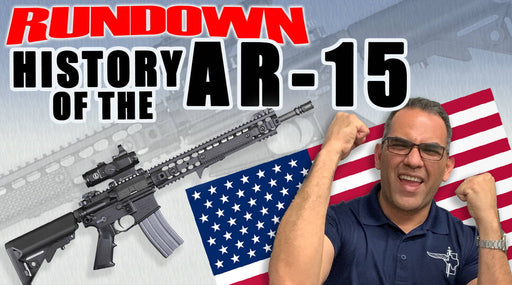Whether you like Glock guns or not, know that they have set a noticeable standard in the gun industry. This is a video on the history of the man Mr. Gaston Glock and the Glock guns that he has created over the years.
Translation:
They're lightweight, they're durable, they're plastic, they're tough. They're in rap songs, video games, movies, and in children's books. Before they even started making handguns, they were in interior designing. This is a rundown on Glock.
With sales of more than 500 million globally in 2017 and nearly 65% market share of the handguns in the US, the Glock handgun is one of the most recognizable firearms in the world. What many people don't know is that the founder of the Glock pistol, Mr. Gaston Glock, didn't start as a gun designer. Glock began as a manufacturer of curtain rods. Curtain rods, are you kidding me? Curtain rods? Curtain rods? Curtain rods? With his wife Helga in the 1960s, and came up with Glock Ges.m.b.H. The letter stand for [foreign language 00:00:54], which translated, literally means a company with limited liability. It's basically LLC.
In '76, he learned that the Austrian army had announced a competition to adopt a new knife bayonet that could be fixed on the iconic bullpup, the Steyr AUG assault rifle made popular by the best Christmas action movie ever, Die Hard, which we'll get back to in a minute. Yes, it was a Christmas movie.
So Mr. Gaston Glock decided to submit his tender on the knife bayonet. The simplicity of the Glock knife presented for the Steyr AUG was pretty much a masterpiece, featuring a polymer grip and sheath. The Glock knife, renamed the M78, was officially adopted by the Austrian army and immediately they ordered 25,000 knives. Once he had his foot in the door, Gaston Glock started developing other field accessories like trenching tools and polymer munition builds.
In early 1980, Gaston Glock happened to be visiting the headquarters for the Austrian Ministry of Defense, the AMD, to promote the sale of his polymer products. While waiting for his meeting, Glock overheard two high ranking officers discussing production of a handgun to replace the Walther P38, which was currently in use. Glock introduced himself to the officers and suggested that he would like to be considered to build the gun. Soon after explaining his business and theories on resonant polymers, he was met with Austrian disdain, or they basically laughed in his face.
Now, apparently that's not something that you do to head of Glock. He cleverly secured himself on the ministries bidders list on his status as a current supplier and receive the specifications for the new gun. The AMD formulated a list of 17 criterias that were to be met for the new generation service pistol. Here are a few. It had to be self-loading obviously, fire the NATO standard 9.9 millimeter Parabellum round, had to be secured against accidental discharge from shock, strike, and from being dropped from a height of two meters on a steel plate. The pistol had to be inspected for wear after 15,000 rounds. It basically
had to shoot plus P ammo. He assembled a team of Europe's leading handgun experts from military police and civilian sports shooting circles.
He asked for their input in designing a new combat handgun. He went to work night and day for the next two years. Within three months, Glock developed a working prototype. The plan was to make use of synthetic materials for a very cost effective pistol. His first pistol took one year to produce from the design and concept stage to production. He applied for the Austrian patent in April 1981 for the pistol that we all know today, as you guessed it, the Glock 17. Now a quick side note. For all you guys who don't know what you want to do in life, maybe you can find some peace and solace knowing that Mr. Glock wasn't planning on changing the entire firearms industry, didn't do it until he was in his fifties. The Glock 17 outperformed eight different pistols from five other established manufacturers, Heckler and Koch in Germany who offered their P7M8, Six Hour Switzerland bidded with their P220 and 226 models.
Beretta of Italy submitted their model 92SB. Ferbig Nationale now proposed an updated variant of the Browning high power and the home grown Steyr arms entered the competition with the Steyr GB. The Glock won hands down and that's impressive because most of these gun manufacturers had been making guns for over a century. The Glock handgun was adopted into service with the Austrian military and police forces in 1982, with an initial order of 25,000 guns. This sparked a wave of interest with the United States where a similar effort was going on to select the service wide replacement for the M1911. Check out our video on the Colt 1911.
I think it's up there down, wherever Dan puts it. Shortly thereafter, Glock 17 became a standard NATA classified sidearm. By 1992, some 350,000 pistols had been sold in more than 45 countries, including 250,000, a quarter of a million here in the United States alone. That's crazy. That's crazy awesome, man. God bless America. Glock 17 wasn't named for its capacity as many people think. Gaston Glock was an inventor and already had 16 patents on file when he started working on the Glock 17. Since the pistol design would be his 17th patent, he called it the Glock, wait for it here it comes, Glock 17.
The coincidence that the Glock 17 could hold 17 rounds in its magazine was nothing more than circumstantial. In 1990, the Glock 17 made its first big appearance in a Hollywood blockbuster movie, Die Hard 2. I told you I was going to get back to the Die Hard movies. Glock didn't care much that the pistol was being used by the bad guys and not the hero. They were just happy that their gun was going to get some exposure in a big time action movie. Now there's a scene where John McClane played by Bruce Willis refers to the Glock 17 as the Glock seven, which is made from porcelain and can't be picked up by airport metal detectors and costs more than a Dulles Airport's chief of police monthly salary.
"Punk stealing luggage."
"Luggage? That punk pulled a Glock seven on them. You know what that is? It's a porcelain gun made in Germany. Doesn't show up on your airport X-ray machines here and it costs more than you make it a month. You'd be surprised what I make in a month."
These mistakes are so obvious and glaring that you have to wonder why someone who knew better didn't speak up and stop this foolishness. Well, someone did. Armor Mike Papac who supplied the movie with firearms used spoke up. He tried to talk the movie makers out of using those lines, but the people in charge wouldn't hear of it. They told Mike that the lines were written into the script, and that was the end of the conversation. So after this, the media touted the Glock as been immune to detection by metal detectors. The birth of a mythical ghost gun. It didn't last long though. The initial thoughts were soon dismissed. All right, let's get down to the pistols. Yes.
Yes. The first generation of Glocks debuted with the Glock 17 in 1982 as previously mentioned, and was chambered in nine millimeter. The Glock 17 was purchased by numerous militaries around the world, and it was presented and demonstrated to police chiefs across the US. Now the law enforcement world was still using revolvers at the time for the most part and a semiautomatic pistol, let alone a lightweight polymer frame model with no manual thumb safety wasn't widely accepted at the time. Side note, many people think that Glocks don't have a safety mechanism. That's simply not true. Glocks come with three independently operating mechanical safeties, which are built into the fire control system of the pistol. Glock calls it the safe action system. It basically allows the user to concentrate fully on shooting without having to disengage and reengage safeties. It also means that it's safe if it's dropped and functions at extreme temperatures. Shooters immediately tried and failed to wear out the pistols by shooting thousands of rounds through them.
Glocks were dropped from helicopters, frozen in ice, dunked in mud, and buried in sand. After all the torture tests, the Glocks continued to perform flawlessly. The soft shooting nine millimeter Glock 17 was lightweight, accurate, and reliable, and immediately became a favorite with the shooters everywhere. In 1986, the Glock 18 was introduced as a select fire variant for law enforcement military use only. With the selective lever in the bottom position, the pistol goes into full auto. The rate of fire in full automatic mode is around 1100 to 1200 rounds per minute. That's awesome. Why can't we have some fun? A tear. In 1988, one of the best sending Glocks As we know it today hit the market, the Glock 19. Police chiefs liked the Glock 17 pistol, but needed more of a compact pistol for detectives and plain clothes officers. The 19 had a shortened grip and smaller magazine for better concealment while still holding 15 rounds in a standard magazine.
The barrel length was also shortened by about a half inch. By this time, everyone was getting in on the Glock action. Competitive shooters demanded and got a pistol of their own as well. It had a longer barrel and slide and was made into the Glock 17 frame. They called it the Glock 17L. Soon after the gen twos were released with more caliber choices. The 40 Smith and Wesson was gaining popularity with law enforcement agencies. So in 1990, Glock introduced the full size Glock 22 and soon after the compact Glock 23 in that caliber. Glocks were given big boar fire as well, more power baby. The Glock 20 was chambered in the 10 millimeter auto while the Glock 21 was chambered in none other than Americ'as
round, the 45 ACP. Cue the eagle. In 1994, the 357 cartridge came out as an answer to replicate the ballistics of the 357 Magnum.
Now Glock saw an opportunity and came out with a Glock 31 full size in 1996. It followed with a Glock 32 compact version soon after that. Quick side note. In 1990, Glock put some record labels on notice to stop using the Glock name in gangster rap songs it was producing. Mainly out of the fear that Glock's name would become a generic term for handgun. Now while many complied, most didn't. They also added a forward accessory rail. These models included the Glock 19C, the Glock 20, the Glock 20C, the Glock 21, 21C 26, 27, 28, 29, 30, 33, 36, and 39.
Glock also introduced the short frame, SF variants for some models. For these, the trigger reach was shortened by slimming down the grips to better accommodate shooters with small hands. The SF models include the big board 10 millimeter Glock 20 SF, and the 45 ACP Glock 21 SF. It was around this time in 1997, that Glock sued Smith and Wesson for patent infringement on its Sigma pistols, AKA the Glock and Wesson. The suit was settled out of court when Smith and Wesson agreed to alter the Sigma and pay undisclosed damages to Glock. In 2002, Glock introduced the 45 GAP or the Glock automatic pistol round, AKA the 45 Glock cartridge. Glock requested this round to equal the firepower of the 45 ACP, but in a shorter cartridge similar to the nine millimeter so that it can fit a more compact handgun. It was a round that was supposed to replace the veteran 45.
As you guys know, it just didn't happen. While all this was going on, in 1999 Glock's long time business associate Charles Ewert, a financial genius hired a former French mercenary to murder head of Glock. Now Ewert was trying to cover up his embezzlement of more than 30 million from the Glock corporation. Ewert took head of Glock to a Luxembourg parking garage to look at a sports car. While there were there, a man came out of the shadows and attacked Mr. Glock. Gaston Glock, who was always physically fit swimming miles daily managed to fight off the hitmen even after being struck in the head with a hammer seven times. The hitman got 17 years in the slammer and Ewert was sentenced to 20. Head of Glock would later say that the attack was the best thing that ever happened to him. "Ill advised I would have gone on trusting Ewert." In early 2010, Glock introduced its gen four pistols, which now features a slightly less aggressive frame texturing than the previous generations.
Gen four models also come with interchangeable backstraps to help with different size hands, a reversible magazine catch, a dual recoil spring assembly which is designed to help reduce felt recoil, and a new trigger system. They also have gen four roll marked after the model number on the left side of the slide. Some of the models that were introduced in the gen four era include the Glock 30S which is a slimmer version of the Glock 30, the Glock 41, which is a competition size pistol chambered in 45 ACP, the Glock 42 which addresses the popularity of the 380 ACP cartridge for concealed carry, and the ever so popular Glock 43, a purposely built concealed carry single stack pistol chambered in nine millimeter.
Glock also introduced the modular optic system or MOS configuration pistols. Now the MOS feature slides that come with mounting plates to accept the variety of popular miniature reflex sights. MOS
includes the Glock 17, the Glock 19, the 34, 35, the Glock 40, and the Glock 41. Glock gen five pistols are the latest examples of Glock's constant pursuit of perfection. Introduced in 2017, the gen five pistols feature over 20 design modifications from the gen four predecessors, including the Glock marksman barrel for increased accuracy, a new nDLC finish on all slides, and a flared mag well just to name a few.
Even the slide cover plate is different. We kind of feel bad for all the guys out there who bought custom cover plates. Well, almost. Not really. Glock has also introduced the Glock 19X, which is a crossover pistol. Its controversial design takes the Glock 19 and adds the larger grip of the Glock 17 for more rounds and better control. Now, a lot of people were dumbfounded thinking, "Why would Glock do that? Why would they make a gun harder to conceal by adding a bigger frame?" Well, the Glock 19X wasn't meant for that. It was built to meet the US Army's modular handgun system specifications. It's made for fighting period.
It's got a lanyard loop and it comes in a code tan color for crying out loud. Soon after Glock introduced the Glock 45. It's basically a Glock 19X without the lanyard loop and in a nondescript black finish mainly to suit law enforcement. Again, some people were not happy. Many thought that when Glock said it was going to introduce another crossover, they were going to get a longer slide on a shorter frame, but who wants to buy a gun that looks like this. Now these crossover guns have sold very well. So well in fact, that Glock took this idea to one of its most praised concealed carry gun, the Glock 43 and made yes, you've got it. The Glock 43X. They made the grip longer for more capacity. It went from a six plus one to a ten plus one round. Unlike its prior X models that made concealment harder with a longer grip, this one is still very concealable.
One of its most recent releases is the Glock 48 or the Canadian Glock 19 as some call it. We'll get to that in a sec. The Glock 48 is a nine millimeter handgun that basically takes the frame of a Glock 43X and adds a longer barrel to it, making it a slim line handgun which is still a great option for concealed carry, especially in Canada. This is because a stock Glock 19 is not legal in Canada don't you know. The Canadian government feels that the Glock 19 barrel is too short and its 15 round capacity is too large. Now Canadian gun laws specify that handguns sold to the general public must have a barrel length of no less than 105 millimeters in overall length. Now the Glock 48 is equipped with a barrel length of 4.18 inches. In metric, that converts to 106 millimeters stepping over the line just enough for legal sale in Canada.
Now, since Canada is one of the largest reoccurring markets for Glock outside the US, it only made sense for glove to make a gun that was legal there. Glock offers over 50 pistols in a variety of sizes, calibers, and styles today. Whether you like Glock or not, there's no mistaking the influence that Mr. Gaston Glock has made on modern firearms today. Guys, thanks for watching. I hope you enjoyed this video. Make sure that you like, comment, and subscribe and go check out Bravo Concealment for everyday carry needs and check out these videos as well. Catch you guys later.





















Leave a comment
1 comment
Bravo is the best !